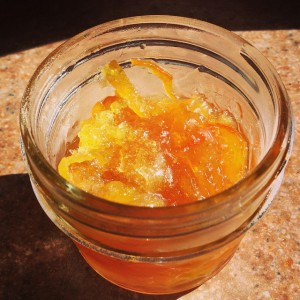Pectin (low-methoxyl pectin and high-methoxyl pectin)
Pectin is a naturally-occurring polysacharride found in many plants. It has long been the mechanism by which jams and jellies are thickened. High-methoxyl pectin requires a significant amount of sugar to gel properly, but low-methoxyl pectin requires less, which is why low-methoxyl pectin has become popular for pastries and molecular recipes designed not to be as sweet. Low-methoxyl pectin can be used as a gelling agent, thickening agent and stabilizer. Low-methoxyl pectin can be used as a fat substitute in baked goods and to stabilize acidic protein drinks such as drinking yogurt.
Pectin Origin
 Pectin is a natural polysaccharide (starch) product extracted from plants, usually from apples or the fibrous cells of citrus peels.
Pectin is a natural polysaccharide (starch) product extracted from plants, usually from apples or the fibrous cells of citrus peels.
Pectin was first extracted by the French chemist Henri Braconnot in 1825. Today, it is commercially available in many forms, including as a powder, a liquid, and mixed with other gelling agents.
Home canners know to add pectin to fruits that contain little pectin themselves, such as berries and grapes. The pectin gives jams body and texture. Food producers have long used pectin to stabilize food products and add texture.
Although pectin may be used in many of the ways gelatin can, pectin has more of a "sticky" texture than gelatin.
Pectin Function
There are two basic types of pectin, though there are many subtypes of pectin within the two basic types. High-methoxyl pectin is the form of pectin traditionally used for canning applications. It requires high amounts of sugar to gel and is very sensitive to acidity. Low-methoxyl pectin has been used in the food industry to create low-sugar jams because it does not require high sugar levels to gel. It is also less sensitive to acidity and requires calcium to gel. Most molecular recipes call for low-methoxyl pectin.
Pectin Applications
Pectin can be used in molecular gastronomy to make a wide variety of dishes. Pectin can be added to sweets and confections to give them texture. Since it's sensitive to calcium, it can be used for spherification. Pectin can be combined with flavoring ingredients and dehydrated to create thin, transparent sheets or edible films.
To create a brittle opaque film, use 15% glucose powder, 1.5% LM pectin and 0.6% agar with 100% of the desired liquid. Cast mixture into a thin film over silicone mat and dehydrate.
Using the gelling properties of LM Pectin you can make a savory pate de fruit with firm and elastic texture using 2% of LM Pectin and 1% of Calcium Lactate Gluconate.
Pectin Properties
In this section, we will specifically address low-methoxyl pectin and not high-methoxyl pectin.
Temperature (gels and melts): LM pectin will hydrate and gel in either cold or hot water. The presence of calcium ions increases viscosity and accelerates gelation.
Texture: LM pectin forms a brittle to very brittle gel, but with slightly more "stickiness" than gelatin.
Appearance: Clear.
Flavor release: Excellent.
Mouthfeel: As a gel, it is similar to the texture of gelatin, just slightly more sticky. As a thickener, it adds body with little cling.
Freeze / Thaw stable: Yes.
Syneresis (weeping): Yes, though syneresis can be reduced with additional calcium.
Shearing: Breaks the gel.
Hysteresis: no.
Interactions and Tolerance of Pectin
PH Tolerance: The ideal range appears to be pH 2.5-5.5, though some sources list 2-7. We assume the exact pH at which the pectin will gel depends on calcium.
Sugar Tolerance: High sugar concentrations inhibit the formation of a gel.
Other Tolerances: Not a good gelling agent for alcohol.
Synergies with other ingredients: LM Pectin requires calcium ions to gel properly. Its viscosity will also be increased in the presence of other cations. LM Pectin is synergistic with Locust Bean Gum.
How to use Pectin
Concentration Range: 0.15-3.1% for most applications.
In smaller amounts, pectin thickens liquids much like the gelatin in a rich stock. At higher concentrations, pectin forms an increasingly stronger gel.
Of note, LM Pectin will form a thermoirreversible gel, which means that it will stay gelled even when heated to temperatures that would normally melt it. This is due to the presence of calcium ions. Read more about thermoirreversibility and pectin here.
Dispersion: Disperse in cold water.
Hydration: Will only hydrate in the presence of calcium. Ideally, you should add the LM Pectin to a liquid with known low levels of calcium. Then, once the pectin is dispersed, add the calcium source to induce hydration and gelling. A calcium sequestrant may also be used to reduce calcium levels enough that the pectin can disperse.
Setting: a gel will form after the introduction of calcium.
[top image: Leslie Seaton]





